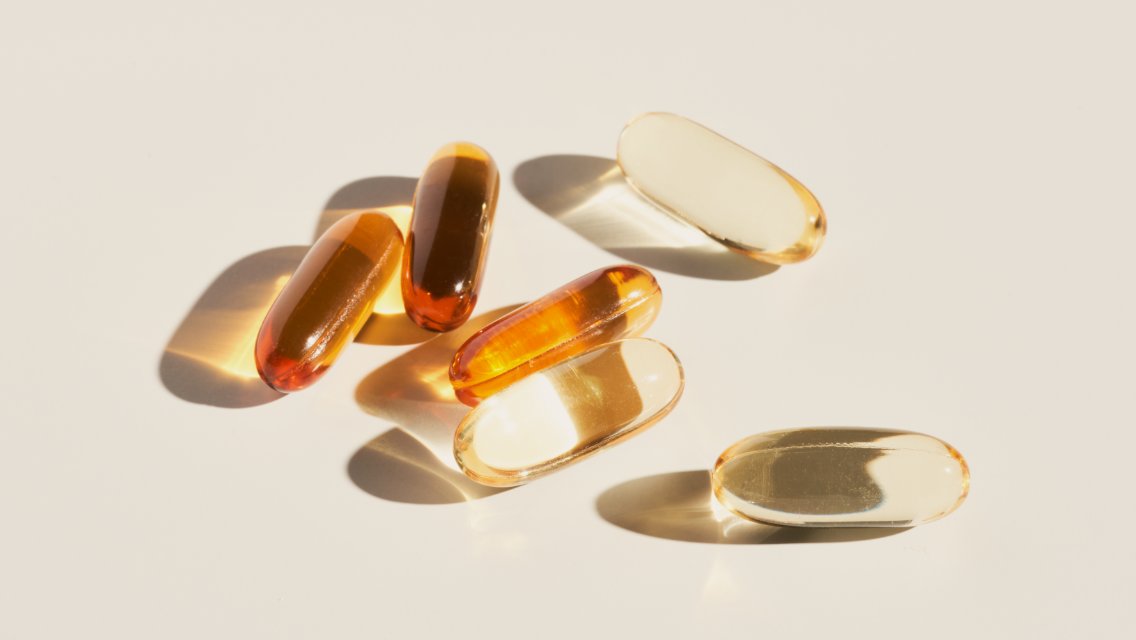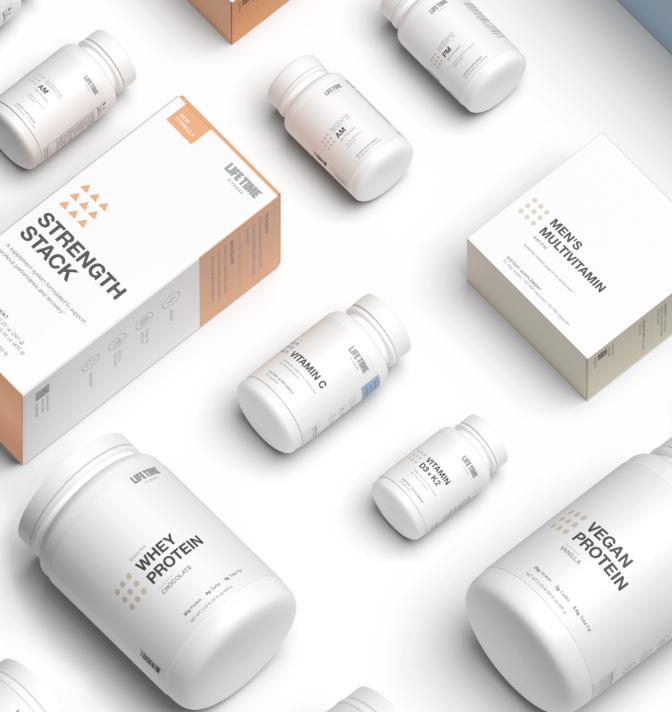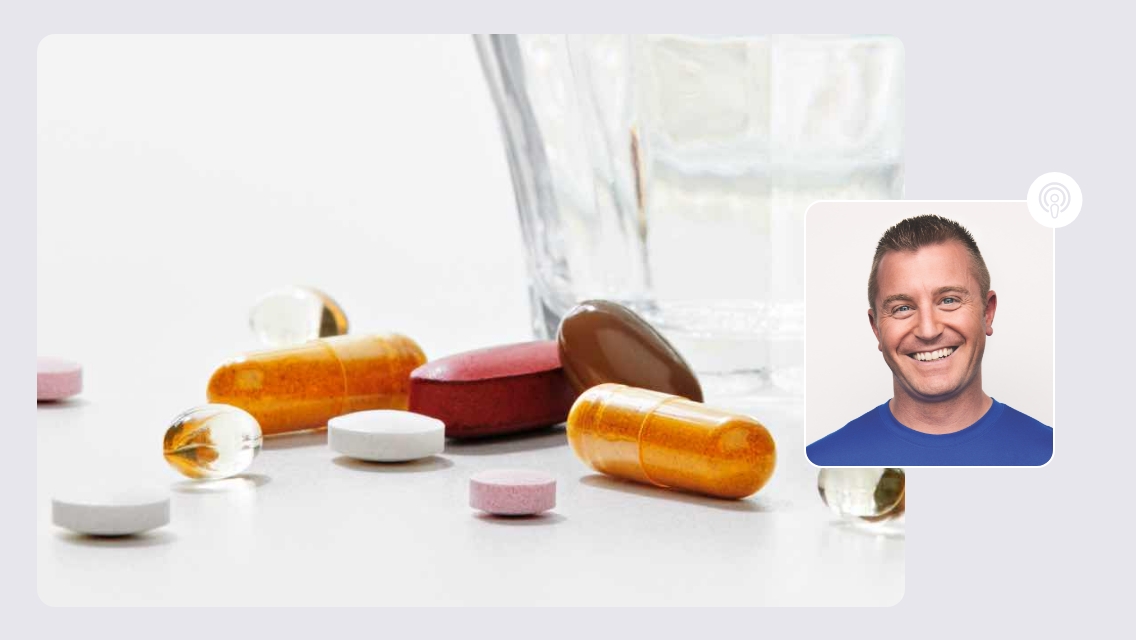1) Vitamin D (with Vitamin K2) ⋅ 2) Probiotics ⋅ 3) Quercetin ⋅ 4) Vitamin C ⋅ 5) Collagen Peptides⋅ 6) Protein Powder
Autumn is a season of significant change, which makes it a great time to recalibrate your health routines — including your supplement regimen.
The modern nutrition environment is rich in ultra-processed, nutrient-poor, uber-palatable foods that are often grown in anemic soils bolstered “supplemented” by industrial fertilizers. We live in an interesting time — one of abundant calories and inadequate nutrition.
One could argue that our demanding modern lifestyles — which often feature high stress, inadequate sleep, and ubiquitous use of prescription and over-the-counter medications — increase nutrient requirements for several essential vitamins and minerals.
That’s why supplements ought to be considered an important part of your overall nutritional lifestyle.
It’s important to note that there’s no supplement so powerful that it can undo a poor-quality diet. Yet, there’s also no diet so perfect that it can’t benefit from some smart supplementation.
Below is a short list of supplements to consider this fall to build, or keep up, your body’s resilience.
Vitamin D3 (with Vitamin K2)
Vitamin D3, or cholecalciferol, is the active form of vitamin D, which really acts as a pro-hormone signaling molecule to influence several critical metabolic processes in the body, including immune response, bone integrity, insulin sensitivity, cardiovascular function, and even mood, to name a few. Vitamin D also regulates calcium absorption in the gut.
Food is not a great source of vitamin D3 unless you eat an abundance of fatty fish (wild salmon or tuna), beef liver, or egg yolks from pasture-raised birds. The most common food source (milk) is fortified with vitamin D3, but the amount you’d need to consume to optimize vitamin D levels much of the year isn’t practical (more than two gallons of fortified milk are needed to provide the 5000 IU (125mcg) many people require daily in the winter months).
Evidence suggests most North Americans — as many as four out of five adults — have either insufficient or frankly deficient blood levels of cholecalciferol to maintain normal, health function of the body. For context, here’s a summary of optimal blood levels of vitamin D3 (often labeled as 25-Hydroxy Vitamin D or 25(OH) Vitamin D).
| OPTIMAL VITAMIN D RISK LEVELS | ||
| Risk Category | NG/ML | NMOL/L |
| Deficient | <40 | <100 |
| Sufficient | 40-80 | 100-200 |
| High Normal | 80-100 | 200-250 |
| Undesirable | 100-150 | 250-375 |
| Toxic | >150 | >375 |
[/vc_column_text]
With enough ultraviolet light exposure (UVB), you can produce enough vitamin D to maintain optimal levels, but that requires 20 to 30 minutes of midday sun exposure to most of your skin without sunscreen. It’s safe to say most people don’t get proper UVB exposure to maintain optimal blood levels above 50 ng/dL in summer months, let alone in the fall or winter.
Most people would benefit from taking additional vitamin D3 at least for part of the year, ideally dosed according to whatever keeps their individual blood levels in the optimal ranges. Supplemental vitamin D3 should be taken along with vitamin K2, which helps direct calcium into the bones instead of soft tissues (like artery walls).
My professional recommendation: Life Time Vitamin D3 + K2
Probiotics
Probiotics are supplemental forms of beneficial bacteria that colonize our lower intestine, or our gut microbiome. These bugs aren’t just idle intestinal passengers; they help metabolize nutrients, generate energy sources for us to use, help maintain gut wall integrity, and even produce most of the “feel-good” neurotransmitter serotonin our brains need. These microbes also play a huge role in our immune response.
There are several factors in our modern lifestyles that make it tough to optimize the gut microbiome, including frequent use of or exposure to antibiotics, common use of indigestion medications, below-optimal fiber intakes, and processed food ingredients (like artificial colors and sweeteners).
The transition from summer to fall comes along with a huge change in temperatures, relative humidity, and more time indoors breathing recirculated air for many of us. These changes can dramatically increase our exposure to potential pathogens we’ll need to mount immune responses to. That extra burden is thought to contribute to the surge in seasonal cold and flu-like illnesses, and the pattern repeats every fall almost like clockwork. Be sure your gut is ready for the extra work.
My professional recommendation: Life Time Multi-Probiotic 30B
Quercetin
Quercetin is a flavonoid present in many richly colored fruits and vegetables such as red onions, broccoli, dark cherries, blueberries, blackberries, apple skins, bell peppers, and others. It functions as an antioxidant that has been shown to help manage histamine response to a wide variety of environmental allergens or irritants.
Seasonal allergies often flare up in the fall as trees drop their leaves for the season and fields dry out, causing a flareup of dust and dander that can be debilitating to some. Suffering from seasonal hay fever, stuffy nose, and/or itchy eyes shouldn’t be a normal occurrence every fall; it’s a sign the immune system is in histamine and mast-cell overdrive.
If you suffer from any of the above seasonal irritation and are tired of trying the snooze-inducing over-the-counter antihistamines and allergy pills, consider adding a quercetin supplement this fall in addition to eating plenty of colorful produce. Quercetin absorption from food sources is known to be poor, which is why supplementing it may be a good idea for many people.
My professional recommendation: Thorne Quercetin Phytosome
Vitamin C
Vitamin C has a few important roles in helping us maintain optimal health and resilience — it helps with iron absorption, protein building (especially collagen creation in connective tissues), supporting energy metabolism, and with protecting our cells from excessive free radical damage.
Bell peppers, citrus fruit, broccoli, strawberries, and Brussels sprouts are some of the top food sources of vitamin C, and it’s relatively easy to obtain adequate amounts if you eat plenty of raw produce. However, extra supplemental vitamin C has been shown to help reduce the frequency and severity of seasonal colds, so if your summer produce intake decreases in the fall while the seasonal illness burden is ramping up, it might make sense to add some extra vitamin C to your supplement regimen.
My professional recommendation: Thorne Vitamin C with Flavonoids
Collagen Peptides
Collagen is a special type of protein that provides the structural matrix for all our connective tissues and bone — that includes the protein that keeps our skin smooth and supple, the protein that keeps our joints healthy, and even the protein that helps hold our organs in place. It’s also a major component of hair and nails. In all, collagen makes up about 30 percent of our total body protein mass and 70 percent of the dry weight of skin.
As we age, exercise, and encounter stress, we can start to lose collagen — we break it down faster than we can rebuild it, especially if we undereat protein and restrict protein options that are the best sources of collagen (poultry skin, pork rinds, organ meats, and slow-simmered meats and fish that that include connective tissues and bones). Consuming collagen helps you grow and maintain your collagen.
Why add collagen in the fall? Temperatures and relative humidity drop significantly across much of North America, which often causes our skin and airways to dry out a bit. Cooler temperatures can open the door for new joint aches and pains to emerge. Boosting collagen and fluid intake can offset these tendencies to help maintain skin hydration and mucus membrane resilience. The skin benefits might help diminish wrinkles and the mucus membrane resilience can help you resist the flareups of seasonal colds and flus that surge in the fall and winter.
My professional recommendation: Life Time Grass-Fed Collagen Peptides
Protein Powder
If you exercise, the Recommended Dietary Allowance (RDA) for protein of 0.8g/kg/day doesn’t apply to you. Your daily protein target is most likely at least double that amount, or about 1 gram of protein per pound of fat-free body mass per day, at a minimum.
As schedules change for many of us in the fall, it can be challenging to maintain healthy habits around all mealtimes, and often the nutritional impact of these changes is that our protein intake drops a bit as we either eat out more or rely on readily available meal or snack options. Carbs and fats are generally easy and plentiful while protein usually requires more forethought and preparation time. It’s just not as easy.
Think of protein powder as a quick, economical, convenient health food. It’s the “easy button” for maintaining muscle and resilience. In my experience, the utility of protein powder and all the benefits associated with it — including appetite control, more even energy levels, lean body mass support, better bone health, strength improvements, and help with fat loss — are unmatched.
For anyone with seasonal allergies or the tendency to suffer from sinus infections or seasonal respiratory illness, I’d recommend limiting dairy proteins in favor of other proteins. Dairy is known to contribute to inflammation or irritation of the sinuses and airways, making it tougher for some people to combat seasonal allergens.
My professional recommendation: Life Time Vegan Protein or Vegan+ All-in-One Shake Mix
Bonus! The Life Time D.TOX Program
Was your summer filled with fun and perhaps too much carefree eating and drinking? Do you feel like you need a “reset” of sorts? If so, one of the best ways to jumpstart a new set of health habits is to commit to at least two weeks of a focused, intentional, nutritional lifestyle reset.
The D.TOX program helps guide participants through a modified elimination diet based on wholesome, unprocessed foods — plenty of delicious recipes included — to help reduce potential inflammatory burden from many common food sensitivities. The optional D.TOX supplement kit helps support the body with nutrients we need to optimize our detoxification systems (protein and amino acids, vitamins, minerals, fiber, and liver-supportive botanical extracts).
Fall is a great time to follow the D.TOX program, especially if you’re someone who experiences seasonal allergies or is susceptible to catching whatever illnesses are “going around.”
My professional recommendation: Life Time 14-Day D.TOX Program
In this season of change, what will you be changing for the better?





